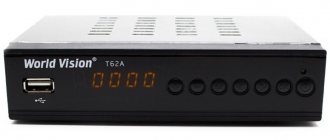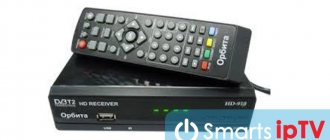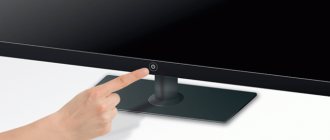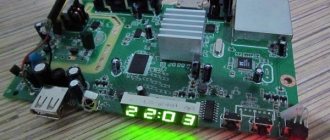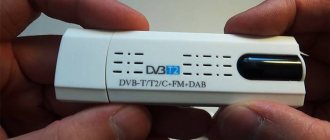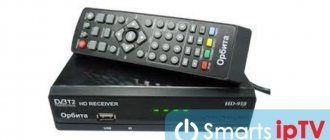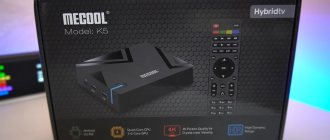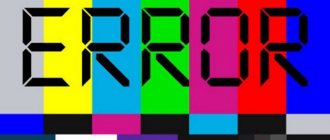Oriel is a fairly well-known manufacturer of digital DVB-T2 set-top boxes. Since 2015, it has released about 10 models of receivers that can easily connect to a TV and receive digital signals directly from home. In addition, as an advantage, owners of such receivers also note the ability to access the Internet from the device itself. This allows you to update the software on time, as well as enjoy additional viewing of videos on various IPTV services and video hosting sites.
We will describe in detail and show in practice the procedure for connecting all models of Oriel set-top boxes. In addition, we will study the connection features for different types of models, and also provide a brief action plan if the device for some reason stops working normally.
Comparison table of Oriel DVB-T2 set-top boxes models
By and large, if you take the entire model range of released Oriel consoles, you will not find any significant differences in them. New devices may additionally be made of a metal case and may be equipped with Wi-Fi adapters. The rest: menu, format support, connectors, etc., remains the same.
| Options | 120/120D | 105/105D | 101 | 302/302D | 403D | 415D | 421D/421UD | 794 | 963 |
| Material | Metal | Plastic | Plastic | Plastic | Plastic | Plastic | Metal | Metal | Metal |
| Display on the body | + | + | — | — | — | + | + | + | + |
| Outputs for DVB-T2 | HDMI and RSA | HDMI and RSA | HDMI and RSA | HDMI and RSA | HDMI and RSA | HDMI and RSA | HDMI and RSA | HDMI and RSA | HDMI and RSA |
| WiFi | — | — | — | — | + | + | + | — | — |
| Remote control | + | + | + | + | + | + | +/+teachable | + | + |
| Nutrition | Internal 220V | External power supply 5V | External power supply 5V | Internal 220V | External power supply 12V | External power supply 5V | Internal 220V | External power supply 12V | Internal 220V |
| USB | + | + | + | + | + | + | + | + | + |
*Set-top boxes: 403D, 415D, 421D, 421UD – are additionally equipped with the ability to receive digital broadcasts from cable television.
Specifications
| Characteristic | Meaning |
| Supported Standards | DVB-T2/T(EN 302755/EN 300744) |
| Demodulator | SONY CXD2837 |
| Modulation | QPSK/16QAM/64QAM/256QAM |
| Guard interval | 1/4, 1/8, 1/16, 1/32, 1/128, 19/128, 19/256 |
| FEC | 1/2, 3/5, 2/3, 3/4, 4/5, 5/6, 7/8 |
| CPU | Ali M3812 |
| Tuner | SONY CXD28611xRF antenna input (IEC-TYPE, IEC169-2 female) 1xRF antenna output (IEC-TYPE, IEC169-2 male) Frequency range: 174-230MHz(VHF)470-862MHz(UNF) Signal level: -15~- 70 dBm |
| Video decoder | MPEG-1/MPEG-2 MPEG-4 AVC/H.264 |
| Audio decoder | MPEG-1 Layer 1.2 PCM/HE-AAC V1.0 |
| Input stream | |
| Image format | 4:3, 16:9, Auto |
| Audio formats | |
| Video outputs | HDMI, Composite |
| Audio outputs | Stereophonic, Coaxial |
| USB port | USB 2.0 |
| Nutrition | 100-240 V, 50/60 Hz |
| Power consumption | 6 W |
The price in stores varies from 1300 to 1900 rubles. How to set up the Oriel digital set-top box is described in the instructions.
table
Diagram of options for connecting the Oriel set-top box to the TV
The Oriel set-top boxes come with RSA cables for connecting them to the TV via AV outputs. However, in practice, this option is not suitable for everyone and here it is necessary to further analyze all the options. The general connection diagram will be considered using the example of the most popular Oriel models - 421 and 963 . However, the connection principle itself will be identical for all models.
The choice of one or another connection option is arranged in descending order, depending on the capabilities of the cable itself:
- First of all, you need to check if there is an HDMI input on your TV. This transmission standard is more acceptable and should be chosen first. The cable provides the best display (picture) and is also more durable than others. The cost of 1 meter of high-quality cable is from 200-500 rubles.
- If this option is no longer available, then further connections will have to be made via RSA (Tulips). They come in several types, depending on the number of plugs on each side. For Oriel there is not much difference. The main thing is that the TV is adapted to the connection.
- Older TVs, in most cases, will not have HDMI and RSA. These TVs will most likely have a SCART input. On the 961 model, such a connector is present initially and all that is required is to buy the appropriate SCART-SCART cable. It will cost you 200-300 rubles.
If you have an Oriel set-top box model without SCART, then you should buy an adapter with Scart-RSA. It costs from 50 rubles and is sold in all stores
Connecting additional audio systems to the receiver
In addition, various Audio systems can also be additionally connected to Oriel set-top boxes. For example, if you previously used a home theater or simply bought more powerful speakers and would like to use them in the process of broadcasting digital channels.
To achieve this, all models had a built-in input for coaxial cable (Coaxial). Using it, you can include additional sound sources in the system and make the display of TV channels more voluminous.
Oriel 790 console reviews
| Mikhail G. Excellent model Advantages: The digital set-top box oriel 790 has a high-quality picture, stable reception, despite the distance of the tower (45 km in a straight line), and switches quickly. |
Even as a child, living in the village, I always tried to tune the TV to good reception of a large number of channels. The only option that I understood for myself from these attempts is that the higher the antenna is, the better the quality of the channels and the greater their number. But there is a limit to the height of the antenna mast. Therefore, some channels were always shown well, some were shown not so well, and some were not shown at all. Now, living in the city, you don’t experience any problems with the quantity and quality of the TV channels provided, but when visiting a village, sometimes you want to turn on the TV and change channels, choosing an interesting program. But in the countryside, time moves slower and modern technologies arrive there late, and sometimes don’t arrive at all.
In this regard, I set out to set up as many television channels in the village as possible. To begin with, I propose to consider what options are available today for obtaining a high-quality signal and picture on the TV:
1 Cable TV
- television, in which the signal is distributed through a television cable that is directly connected to each television
Pros: high-quality TV.
Cons: Subscription fee, available only in large cities.
2 Satellite television.
Satellite television broadcasts using a satellite suspended in low-Earth orbit. The signal is received by TV viewers on an individual dish antenna.
Pros: high-quality TV.
Cons: Cost of equipment, subscription fee.
3 Terrestrial television
. Terrestrial television distributes the signal using terrestrial repeater stations; in order to receive this signal, you must use an antenna.
Pros: minimum costs.
Cons: the signal level is often low; the display and quality of channels depends on the weather, distance from the tower, mast height, etc.
You can also say that TV channels can be watched via the Internet, but in this article I would like to talk about watching channels without using a computer/laptop, and especially the Internet.
Of all the methods described, the only one that suited me was using satellite TV, but I really didn’t want to spend money on buying equipment and then paying a subscription fee. After rummaging on the Internet, I found an alternative way - terrestrial digital television
. The essence of digital television is the following: the transmission of television images and sound occurs using digital encoding of the video signal and sound signal using digital channels. Digital encoding, unlike analogue, ensures signal delivery with minimal losses, since the picture and sound are not influenced by external factors (interference). Of the nuances of using digital television, I will note the following - a television channel in digital television has two situations, it will either work in good quality, or it will not work at all. Unlike analog TV, there is no borderline state or interference, the only exception is if the channel has very poor communication quality, it can slow down, turn off and turn on again, to avoid this you need to use another antenna, raise the existing one higher or turn towards the TV tower .
What you need to watch digital television:
TV antenna;
TV or set top box (Set Top Box) with DVB-T2
(namely DVB-T2, the outdated DVB-T will not work), support for the MPEG4 video compression standard and the Multiple PLP mode.
You do not need to buy an additional antenna, just use an antenna for an analog signal. But the antenna itself is not enough, to watch digital TV you need a set-top box with a DVB-T2 tuner (some modern TVs do not need such a set-top box, since it is built into the TV, this information can be obtained from the documentation for the TV or on the manufacturer’s website, which discusses a similar case ). Set-top boxes are not expensive, on average from 1500 to 2000 rubles. In fact, you don’t need to buy anything other than this set-top box. Another plus is that you don’t need to pay a subscription fee for terrestrial digital television.
It is important to note that digital TV allows you to view a limited number of channels; at the time of writing there were 20 (possibly less depending on the region of residence).
Digital television is not configured according to the principle - the higher you raise it, the more you catch. You can only tune these 20 channels, plus you can add more analog channels that your antenna will pick up (if your DVB-T2 set-top box or your TV has such a function). To learn more about the number of channels and the possibility of using digital television in your region, you can call the RTRS hotline: 8-800-220-20-02 (calls within Russia are free) or on the website: www.rtrs.rf.
So, I propose to move from theory to practice. In my case, I used a regular television antenna, which was very popular about 15 years ago. With this antenna I managed to catch about 3 analogue channels in good quality, 2 in satisfactory quality, and a couple more channels appeared in poor quality in good weather.
I purchased a DVB-T2 set-top box. Regarding the choice of consoles, I didn’t rack my brains, since technically they are all as similar as two peas in a pod. Most of them have two outputs - tulip (some SCART) and HDMI, there is a USB connector for viewing the contents of USB media. I got the impression that they are all made at the same Chinese factory, only they are equipped with different boxes and labels. When purchasing, pay attention to the control panel of the set-top box, since you will use it constantly (switch channels, turn the volume lower, higher, etc.).
I connected the antenna to the DVB-T2 set-top box, and connected it to the TV using a tulip (it usually comes with the set-top box).
Tulip RCA connectors for video and stereo audio. Yellow is for video, white is for monaural or left channel of stereo two-channel audio, and red is for right channel of stereo two-channel audio.
I’ll make a reservation right away that I connected the set-top box to an obsolete CRT TV, so I chose a tulip cable. If you have an LCD or plasma TV with an HDMI output, then you should connect it with a proper HDMI cable (it must be purchased separately), since the image quality will be much higher.
I switched the TV to AV mode and got to the DVB-T2 set-top box interface. Setting up the set-top box requires minimal effort; all default settings will satisfy most users. The main thing you need to do is set up the channels. To do this, I went to the channel search menu and selected Auto search.
A few minutes later, the DVB-T2 set-top box found those same 20 channels + 3 radio stations. But a few days later, channels 11 to 20 disappeared, on the website rtrs.ru I saw that the towers to which I connected did not support 2 multiplexes (from 11 to 20 channels), and the fact that they worked for a couple of days was most likely tests. As a result, I purchased a high-quality, “strong” antenna to watch all 20 channels. Test video below.
Setting up digital channel search on Oriel
In order to catch all 20 digital channels, it is not enough just to know the instructions for the set-top box. Please check in advance whether you need a new antenna. The search process itself will be similar for all models of the company's receivers. Therefore, regardless of what model of console you have: 421, 963, 120, etc., the settings will be identical:
- First, select the signal display mode required in your case from the TV menu. It is taken depending on the method in which the console was connected. For example, if this was done using a tulip, then you should switch to AV mode.
- After this, you need to press the power button on the set-top box or its remote control.
- A welcome window will open. It will ask you to indicate your country and select a language. Typically this option is already set. It is better not to touch the remaining settings unless you know the exact ratios for the sides. Click OK.
- An automatic channel search should start. At the same time, the set-top box will pass through all frequency ranges in the visibility zone and find digital channels available for viewing. When finished, the list should save itself.
Poor image quality
Poor image quality is due to network outages. The second option is that the cable or plug has come loose. Check the connections of the components and turn on the receiver again.
Mila Artyukhova (Articles written: 40)
I connected the Oriel set-top box, after tuning the channels, recording starts - no TV
Hello, what model of TV?
Extra channels have appeared without an image, how to remove them, Erison TV
Hello, if it is a receiver, then the list of channels is called up with the List button, then on the desired channel, the Edit button (green), then the Delete item. The channel is moved to the trash can.
I turn it on, it shows, after 2 minutes it says: this video format does not support “what could this be?
Hello, what model of TV?
My TV and radio settings have been erased, how can I restore them?
Hello, go to the settings section of your TV.
First select “Automatic settings”, then “Auto search”. The system will try to find channels.
If there is no result, you should try searching manually. To do this, select the “Manual configuration” subsection, set the required parameters there, after which the process starts.
Source
Connecting WiFi to Oriel set-top boxes
Some of the set-top box models presented in the table above have a built-in WiFi receiver and can easily connect to the Internet. This is very convenient and allows you to turn your device into a real multifunctional cinema. A wireless network allows you to:
- Watch videos on YouTube and Megogo.
- Find out the weather in your region.
- Connect to news feeds.
- Watch more than 20 channels using IPTV.
- Update the device.
To connect, you will additionally need to purchase an adapter, which is a Wifi antenna and connected via USB.
Firmware update and factory reset
When a new version of the set-top box software is released, it may not start working correctly with those TVs that previously had good contact with it. Therefore, in some cases it may be necessary to change the firmware of the set-top box to a new one, or if something goes wrong, return everything to the factory settings.
This can be done through the receiver menu:
- To do this, go to “Tools” and select updating the receiver via USB or via OTA.
- In the first case, the new firmware version should be installed on a flash drive.
- In the second case, wifi is required.
- If you want to reset all settings to default, you should select factory settings.
Password for resetting the device and entering the update menu: 1234
Reviews for Oriel consoles
Currently, the company occupies its niche in the field of sales of digital receivers. At the same time, users note the high reliability of the devices and adaptation to a large number of connection options. Some of the latest models of set-top boxes can be successfully connected to a TV using 3-4 connection methods.
This in turn makes these receivers universal. When selling them, you can be 99% sure that the device will be able to contact TVs and will not cause any problems during operation. The cost of the company's receivers today varies around 900-1200 rubles. This is affordable for most TV viewers. Moreover, for that kind of money you will also get the opportunity to connect to the Internet.
Oriel is a fairly well-known manufacturer of digital DVB-T2 set-top boxes. Since 2015, it has released about 10 models of receivers that can easily connect to a TV and receive digital signals directly from home. In addition, as an advantage, owners of such receivers also note the ability to access the Internet from the device itself. This allows you to update the software on time, as well as enjoy additional viewing of videos on various IPTV services and video hosting sites.
We will describe in detail and show in practice the procedure for connecting all models of Oriel set-top boxes. In addition, we will study the connection features for different types of models, and also provide a brief action plan if the device for some reason stops working normally.
Comparison table of Oriel DVB-T2 set-top boxes models
By and large, if you take the entire model range of released Oriel consoles, you will not find any significant differences in them. New devices may additionally be made of a metal case and may be equipped with Wi-Fi adapters. The rest: menu, format support, connectors, etc., remains the same.
| Options | 120/120D | 105/105D | 101 | 302/302D | 403D | 415D | 421D/421UD | 794 | 963 |
| Material | Metal | Plastic | Plastic | Plastic | Plastic | Plastic | Metal | Metal | Metal |
| Display on the body | + | + | — | — | — | + | + | + | + |
| Outputs for DVB-T2 | HDMI and RSA | HDMI and RSA | HDMI and RSA | HDMI and RSA | HDMI and RSA | HDMI and RSA | HDMI and RSA | HDMI and RSA | HDMI and RSA |
| WiFi | — | — | — | — | + | + | + | — | — |
| Remote control | + | + | + | + | + | + | +/+teachable | + | + |
| Nutrition | Internal 220V | External power supply 5V | External power supply 5V | Internal 220V | External power supply 12V | External power supply 5V | Internal 220V | External power supply 12V | Internal 220V |
| USB | + | + | + | + | + | + | + | + | + |
*Set-top boxes: 403D, 415D, 421D, 421UD – are additionally equipped with the ability to receive digital broadcasts from cable television.
Diagram of options for connecting the Oriel set-top box to the TV
The Oriel set-top boxes come with RSA cables for connecting them to the TV via AV outputs. However, in practice, this option is not suitable for everyone and here it is necessary to further analyze all the options. The general connection diagram will be considered using the example of the most popular Oriel models - 421 and 963 . However, the connection principle itself will be identical for all models.
The choice of one or another connection option is arranged in descending order, depending on the capabilities of the cable itself:
- First of all, you need to check if there is an HDMI input on your TV. This transmission standard is more acceptable and should be chosen first. The cable provides the best display (picture) and is also more durable than others. The cost of 1 meter of high-quality cable is from 200-500 rubles.
- If this option is no longer available, then further connections will have to be made via RSA (Tulips). They come in several types, depending on the number of plugs on each side. For Oriel there is not much difference. The main thing is that the TV is adapted to the connection.
- Older TVs, in most cases, will not have HDMI and RSA. These TVs will most likely have a SCART input. On the 961 model, such a connector is present initially and all that is required is to buy the appropriate SCART-SCART cable. It will cost you 200-300 rubles.
If you have an Oriel set-top box model without SCART, then you should buy an adapter with Scart-RSA. It costs from 50 rubles and is sold in all stores
Connecting additional audio systems to the receiver
In addition, various Audio systems can also be additionally connected to Oriel set-top boxes. For example, if you previously used a home theater or simply bought more powerful speakers and would like to use them in the process of broadcasting digital channels.
Setting up digital channel search on Oriel
In order to catch all 20 digital channels, it is not enough just to know the instructions for the set-top box. Please check in advance whether you need a new antenna. The search process itself will be similar for all models of the company's receivers. Therefore, regardless of what model of console you have: 421, 963, 120, etc., the settings will be identical:
- First, select the signal display mode required in your case from the TV menu. It is taken depending on the method in which the console was connected. For example, if this was done using a tulip, then you should switch to AV mode.
- After this, you need to press the power button on the set-top box or its remote control.
- A welcome window will open. It will ask you to indicate your country and select a language. Typically this option is already set. It is better not to touch the remaining settings unless you know the exact ratios for the sides. Click OK.
- An automatic channel search should start. At the same time, the set-top box will pass through all frequency ranges in the visibility zone and find digital channels available for viewing. When finished, the list should save itself.
Manual search
If the set-top box, for some reason, could not find 20 channels or does not see signals at all, then you should reconfigure it in manual search. Its meaning is to set the device the exact frequency at which it will scan the entire flow of information and be able to provide you with the digital channels available on it. It's very easy to do this:
- Find out your frequency for DVB-T and DVB-T2 channels. To do this, go to the interactive map of CETV and look at the parameters of the television tower closest to you.
- Press the OK button on the remote control. The device should go to the menu.
- Select “Manual search” in the channel settings section
- After that, in the search mode, set “By channel” and select the number that was previously taken on the map. If the signal has not changed and the intensity graph shows 0%, then try also turning on the antenna power. It is used if you additionally use a signal amplifier.
Antenna test video ANT-T2-MAX
In order to understand the capabilities and settings of this set-top box, I offer a photo of each menu item (please excuse the low quality of the photo).
A digital set-top box, as I wrote earlier, can play files from a USB flash drive. To do this, insert the USB device into the set-top box, go to the menu, select “USB” - “Multimedia”, select the playable format (music, pictures, video).
In addition, digital set-top boxes have the ability to record images from the TV to a flash drive. To do this, just press the “Rec” button on the control panel of the DVB-T2 set-top box, after which the recording will begin on a USB device.
To summarize, I am very pleased with the quality and quantity of digital TV channels (of course, more channels are possible, but not all at once). In my opinion, for remote places, dachas, villages, towns, where people are not ready to spend 10,000 rubles on purchasing satellite TV + pay a subscription fee, I consider this option the most suitable.
There is another addition to the line of terrestrial digital television set-top boxes produced under the Oriel brand. Two new models have appeared. This review will be devoted to one of them, namely the DVB-T2 receiver. The device is made in a metal case, and, despite its relatively small size, it has a built-in power supply. And, of course, it has all the necessary functions for watching and recording television broadcasts. It can be noted that such set-top boxes appeared during the systematic transfer of television broadcasting in our country to a digital format. As a result, today there is a real, and most importantly, simple opportunity to solve the problem of high-quality television reception, for example, outside the city at your summer cottage. It is precisely for their dachas that people mainly buy digital TV set-top boxes, at least here in St. Petersburg. Is it different from similar devices from other brands? I think you will understand this as you read this review.
Main features of Oriel 120.
In this receiver, as in many other DVB-T2
set-top boxes of various brands use a combined
MSD7T01 processor
from MStar Semiconductors, which includes a demodulator and RAM, and
the Rafael Micro R836 tuner
.
By the way, such a combination has already been encountered in one of the revisions of the Kaskad VA2206HD
.
Due to the use of a combined processor, the number of radio elements was reduced, which, accordingly, led to a reduction in the size of the board and the device case. The Oriel 120 receiver
looks quite compact, and at the same time, as I mentioned in the introductory part of the review, it has a built-in power supply.
The base and top cover of the device are made of metal and are equipped with large ventilation slots for better heat dissipation; the front panel is plastic. It and the top cover are initially covered with a protective transport film.
As you can see, the surface of the front panel is made of a combined matte-glossy surface. In the central part of the front panel there is a segment display. When the Oriel 120 receiver
is in standby mode, the clock is displayed on this display; in operating mode, the TV channel number is shown on the display.
In addition to the display, the front panel of this DVB-T2
set-top box has a power button, buttons for cyclic switching of TV channels, a USB port, an IR sensor and an LED indicator. I would call it a shutdown indicator, because... in standby mode, this indicator glows red, but in the operating mode of the receiver it simply does not light up.
On the rear panel of the Oriel 120 receiver there are switching connectors. The set-top box has a standard antenna input
(RF IN) and
antenna loop-through output
(RF OUT),
audio/video output
(HDMI), regular
composite video output
(VIDEO) along
with stereo audio output
(R-AUDIO-L) and
digital audio output
(COAXIAL).
The standard configuration of the DVB-T2 receiver is traditional for digital television set-top boxes of this brand. As you can see, it is minimal and includes only a remote control with batteries, and an instruction manual with a warranty card. There is still no cable to connect to the TV.
Connecting Oriel 120 to TV.
First of all, a little general explanation for those who, as they say, are not in the know. Such devices are not antenna amplifiers; in modern LCD TVs, such a DVB-T2 tuner, as a rule, is already built-in.
A digital set-top box, like all other similar receivers, is essentially a “piece” of a modern TV, designed as a separate unit that can be easily connected
almost
any
, even a CRT
TV
.
When using this external DVB-T2 tuner (receiver), your TV acts as a monitor and speakers, and the set-top box does the rest. Therefore, to receive an on-air digital signal to the receiver, it is imperative to connect an antenna. Without it, there will be no “miracle”; you will not see anything.
If we do not take into account the reception conditions in any particular place, then we can say that a UHF television antenna is suitable
, even from the 90s of the last century. And the reception conditions will determine which antenna can be used - indoor or outdoor, with or without an amplifier.
Further connection of the Oriel 120 digital receiver to a TV is practically no different from connecting, for example, a DVD player. You need to supply image and sound to the appropriate TV inputs. To do this, you can use the HDMI
or
RCA
outputs. It all depends on the availability of certain input connectors on your TV.
After connecting the necessary connectors to the TV and receiver, turn on the Oriel 120
plug into the outlet, and in the TV menu
select the appropriate AV or HDMI input
.
When you turn on the device for the first time, the start menu appears, where the user, if necessary, can change the menu language and region, or immediately begin an automatic search for available television channels.
Automatic and manual search for television channels.
The digital set-top box is controlled exclusively using the remote control. Without it, full operation of the device is impossible, despite the presence of several buttons on the front panel of this receiver.
Terrestrial DVB-T2 receiver Oriel 120
equipped with the 6th series control panel (
PDU-6
). The remote control is convenient. The buttons are rubberized and press softly. In addition to the main ones, there are additional buttons; they provide quick access to some of the receiver’s functions. The remote control is powered by two AAA size elements (R03, “pinky”).
To start auto-searching for TV channels when you turn on the receiver for the first time, simply select the “Search for channels”
on the start screen and press the
“OK”
on the remote control.
During the search process, lists of found television and radio channels are displayed on the screen. Their number depends on the number of packages (multiplexes) broadcast in a given region. For example, in St. Petersburg and the Leningrad region, today we have the 1st (RTRS 1 package) and 2nd (RTRS 2 package) multiplexes available, which is a total of 20 television and 3 radio channels.
The found channels are stored in the set-top box's memory, by default they will be sorted according to their logical numbers (LCN). After the search process is completed, it switches to the TV program display mode, and the channel with the first logical number is turned on.
If, initially, you have doubts about the performance of the antenna, about the correct direction to the translator, then when tuning TV channels it is better to use the manual search mode. To do this, press the “MENU”
“right”
arrow button , go to the
“Channel Search”
, and there, by pressing the
“down”
, select the
“Manual search”
.
Manual search for available TV and radio channels in the DVB-T2 receiver Oriel 120 is carried out by channel number. For example, in St. Petersburg we broadcast on 35 (RTRS-1 channel package) and 45 (RTRS-2 channel package) channels.
The numbers and frequencies of TVKs (broadcast channels) for any region of Russia can be found on the main website of RTRS.RF
, there is an interactive map, or on regional digital terrestrial television sites.
After entering the number of the channel on which the broadcast is being carried out, the quality and signal strength values will be displayed
. Based on them, you can, for example, without any instruments, assess the situation with the reception of an on-air digital signal in specific conditions. If the scales are not filled at all, then it makes no sense to start setting up TV channels, they won’t be found anyway. It is necessary to understand the reason for the lack of reception, check the antenna, cable, etc., achieving maximum, stable (stable) values of signal power and quality. The higher the numbers, the better. For example, by turning the antenna and focusing on changes in the fill level of the scales, you can, if necessary, more accurately direct it towards the transmitting station. But you need to take into account that the data, after rotating the antenna, does not change instantly, but with some delay.
Here it should be clarified - the “power”
“quality”
scale is decisive ; for normal operation it must be more than half filled. Otherwise, the image will “slow down” or “scatter” into squares, and the sound will “stutter.” This is, for example, how the image on the TV screen will periodically look when the signal from the antenna is poor.
Simply put, the “Power”
shows the presence of a signal at the receiving point, and the
“Quality”
shows how the set-top box “understood” and processed this signal.
Functionality and menu of the Oriel 120 receiver.
While watching, you can display information about the current and next program on the TV screen, view the broadcast frequency, and evaluate reception conditions using scales of signal strength and quality. “INFO” button once or twice.
on the remote control.
By filling out the gray scale
, which you see in the left picture, you can quickly estimate the time that has passed since the start of the current transmission.
When you click OK
A list of tuned channels is displayed on the TV screen.
To quickly jump to the desired channel, select it from this list using the “UP/DOWN”
on the remote control and press the
“OK”
.
You can also dial the corresponding number using the numeric keys of the remote control. To cycle through TV channels, you can use the UP/DOWN
on the remote control or front panel.
If you press the "EPG"
, then
an electronic program guide
.
The channels “NTV”, “Channel One”, “Russia 1”, “Russia Culture”, “Karusel” and “TVC” broadcast teletext and programs with closed subtitles, which hard of hearing people can display on the screen using teletext.
To change the settings and to more fully use the capabilities of the receiver, you will definitely have to look at the menu of this set-top box; I already briefly mentioned it a little higher, when I talked about the search modes for TV channels.
To display the main menu of the set-top box on the TV screen, press the “MENU”
.
Contents of the main menu of the Oriel 120 receiver.
Section: "Program".
In this section of the menu, the first two items are of greatest practical importance. As the name suggests, when you select “Edit Channels”
The channel editor opens. By default, you will need to enter the password “000000” to access the editor.
Configured channels can be moved around the list, skipped, blocked, deleted and grouped, for example, by topic, or renamed.
When selecting "EPG"
the same program guide opens as after simply pressing the
“EPG”
on the receiver’s remote control. From there, by the way, you can go to the scheduler.
When creating a schedule, you can schedule both recording and viewing programs
. It is possible to complete the task once, daily or even weekly.
Section: "Image".
As you can see, this section contains settings for screen aspect ratio (proportions), resolution and TV format.
Section: “Search for channels.”
In this section, you can use automatic or manual channel search, change the region, and turn on/off the power supply to the active antenna amplifier.
Section: "Time".
The DVB-T2 digital standard supports time transmission, so by default the receiver is able to automatically set the desired value.
And in this section, if you set the value of the “Setup Mode”
—
Manual
, if necessary, you can force the time zone to be selected.
In addition, here you can configure the period of time after which the receiver will automatically turn off (from 1 to 12 hours with an interval of 1 hour).
Plus, in this section you can set the time for turning on and off the set-top box.
When selecting “Timer”
in the
“Time”
, the scheduler window opens.
Here you can also add, view, edit tasks for recording or watching TV shows on a schedule
Section: “Language settings”.
In this section you can change the language of the main menu, subtitles, audio and set digital audio parameters.
Section: "System".
This section, as its name suggests, contains system settings. You can enable and configure parental controls, change and set a password, restore factory settings, view device information, and update software.
Section: "USB".
This section includes a media player that opens when you select “Multimedia”
.
It allows you to play music, digital photos and video files. Video playback is possible in HD and Full HD (1920x1080) quality, but only with stereo sound. The Oriel 120 receiver does not support the AC-3 (Dolby Digital) codec
.
Here, in the “USB”
, the aspect ratio, time and presentation mode when viewing images are adjusted (item
“Setting photo viewing”
).
In the item “Setting subtitles”
You can change the font size, background, and color when displaying subtitles when playing movies.
Item “PVR Settings”
contains information and settings of an external USB drive if it is connected to the Oriel 120 set-top box.
Like any other terrestrial digital DVB-T2 receiver
, the receiver supports the TimeShift function (Delayed viewing) and allows you to record TV shows on a USB storage device (Flash, hard drive (HDD), etc.).
The TimeShift function, when used, reserves part of the disk space of a connected USB device and performs background recording of the selected channel, thereby allowing you to pause while watching a program and continue watching from where you stopped.
To quickly record the current TV show, just press the “REC”
.
All recorded information will be saved on a USB drive in the HBPVR folder, which the Oriel 120 receiver
creates automatically.
Results.
In conclusion, I can say that, in general, the presented model is a good modern set-top box for receiving public terrestrial digital television channels. The built-in media player copes well with playing files of the most common “network” formats, but in films it only “understands” stereo sound; the device does not support multi-channel sound Dolby Digital (AC3 codec) and DTS
.
As you can see, in terms of hardware and functionality, the Oriel 120 digital terrestrial receiver
very similar to the older model -
DVB-T2 set-top box Oriel 314
.
Only the Oriel 314
used the MaxLinear MXL608 tuner, and the Oriel 120 installed, judging by the very affordable price of the device, the cheaper
Rafael Micro R836
. And I would not confidently say that such a replacement did not in any way affect the quality of digital television signal reception in problem areas. Although, practice will tell.
As for the differences from devices from other manufacturers, many of the latest DVB-T2
Receivers from different brands are built specifically on the MSD7T01+R836 combination and differ only in appearance.
Connecting WiFi to Oriel set-top boxes
Some of the set-top box models presented in the table above have a built-in WiFi receiver and can easily connect to the Internet. This is very convenient and allows you to turn your device into a real multifunctional cinema. A wireless network allows you to:
- Watch videos on YouTube and Megogo.
- Find out the weather in your region.
- Connect to news feeds.
- Watch more than 20 channels using IPTV.
- Update the device.
To connect, you will additionally need to purchase an adapter, which is a Wifi antenna and connected via USB.
Firmware update and factory reset
When a new version of the set-top box software is released, it may not start working correctly with those TVs that previously had good contact with it. Therefore, in some cases it may be necessary to change the firmware of the set-top box to a new one, or if something goes wrong, return everything to the factory settings.
This can be done through the receiver menu:
- To do this, go to “Tools” and select updating the receiver via USB or via OTA.
- In the first case, the new firmware version should be installed on a flash drive.
- In the second case, wifi is required.
- If you want to reset all settings to default, you should select factory settings.
Password for resetting the device and entering the update menu: 1234
Possible problems and their solutions
Sometimes users encounter unexpected problems while using the Oriel set-top box. Often the reason is hidden in a system failure. Most problems can be fixed on your own, but if they happen constantly, then it is better to go to a service center.
Oriel box does not find channels
If the set-top box refuses to detect TV broadcasts, check for updates. Remember that any system requires regular updates. Go to the official website of the developer and check the latest patches in the appropriate section. Download the file to a flash drive, insert it into the set-top box, go to the menu and select “Update via USB”.
If the error persists, try resetting the settings. The function is located in the “System and TV” category. After the procedure, all information will be deleted and settings will be reset.
Does not respond to the remote control or the button does not work
Initially, make sure that the reason is not due to dead batteries. The second reason is the long distance, that is, you are trying to use the remote control while being too far from the console. Are you doing everything right? It may be time to replace the remote control with a new one or send it in for repair.
No signal
The lack of a signal is often due to technical work by the provider. Call the hotline and clarify the question; maintenance work is probably underway and therefore the broadcasts are unavailable. Also, the reason may be due to unfavorable weather or a damaged cable.
Poor image quality
Basically the reason lies in the antenna, put it in another place. Also make sure that the cables and connectors are not damaged.
Reviews for Oriel consoles
Currently, the company occupies its niche in the field of sales of digital receivers. At the same time, users note the high reliability of the devices and adaptation to a large number of connection options. Some of the latest models of set-top boxes can be successfully connected to a TV using 3-4 connection methods.
This in turn makes these receivers universal. When selling them, you can be 99% sure that the device will be able to contact TVs and will not cause any problems during operation. The cost of the company's receivers today varies around 900-1200 rubles. This is affordable for most TV viewers. Moreover, for that kind of money you will also get the opportunity to connect to the Internet.
Everything about setting up digital television of the DVB T2 standard
I assume that you have read the previous articles and followed the algorithm I described, but nothing worked for you. If this is not the case, then I recommend that you read all this, perhaps your problem is solved in the early steps. For example, you are simply not in the digital TV reception area or you have an old receiver.
Now let’s try to figure out what’s wrong and why your digital television is not showing. I’ll say right away that this article will focus specifically on setting up the set-top box and antenna . That is, we do not consider repairing the devices themselves, and assume that they are working properly.
The auto search found nothing, and the set-top box says “No services”
If the auto search did not find anything, and the set-top box writes “No services”. Or the channels stopped showing, and instead of them there is also “No services” - the problem is a bad signal.
“No services” is a sure sign of a weak signal
You need to do a manual search on the frequencies on which your signal is transmitted. We take the frequencies here. The problem is that auto search with a weak signal simply does not find anything, while manual search will show you the strength of the transmitted signal, even if it is very weak.
Example from life
I already wrote that I caught the first number on simple “horns” in the city center, on the second floor and there are few buildings around. The signal quality is excellent. Intensity 80%, quality 60-80%
The higher the quality and intensity, the better
But when I moved to another area of the city, to an apartment on the 9th floor, a house in a low area and many other houses around – these horns did not catch anything. More precisely, the auto search did not catch anything. I was very surprised (the tower is located nearby), I entered the frequency manually through a manual search (which I advise you to do), and it turned out that the signal level was 10-15%! This is clearly not enough for reliable reception of digital TV.
How to check signal quality when setting up digital TV
Check that the signal is strong enough and everything is set up well.
It's very easy to do. You should have an INFO button on your set-top box; pressing it three times displays data on the quality and intensity of the signal. Look in the instructions, it may be called differently, but it will do the same thing:
The higher the signal, the better. Optimal - from 60% onwards
If both indicators are high, above 60%, everything is fine.
Check on both multiplexes, say, on Channel One and TNT.
Since different multiplexes are transmitted, you can catch the first one well, and the second one poorly, or vice versa. Your task is to rotate the antenna so that both are caught well.
But in practice it happens a little differently. For example, you can catch duplicates. When identical channels will occupy several places at once. It doesn't seem critical, but it's annoying. How to treat, I.
If there are “friezes” (the picture falls apart into cubes)
We look at the signal level. To see the signal level, find the INFO button (or something similar) on the remote control and press it three times: you will see this:
Reception is on the verge of quality - only 36%
The same thing may happen to you if you are far from the tower, or there are many buildings around that interfere with reception .
Important: if both the intensity and quality are low, the signal must be amplified.
Either buy an antenna with an amplifier, or put the existing one outside, raise it higher, and so on.
How to connect everything
First, connect the antenna to the receiver, and the receiver to the TV
. Preferably via an HDMI cable, so the image quality will be as clear as possible. If there is none, then through ordinary “tulips”, they usually come complete with the console. Look at the connectors in the instructions, you will get something like this. If the antenna has an amplifier, first turn it off, then you can always turn it on.
We launch all this equipment, set-top box, antenna, TV. Select the desired video input. If everything is done correctly, you will see a start menu like this:
How to set up the antenna itself
But if the intensity is high, but the quality is low, then it’s more interesting. You will need to adjust the antenna. That is, in fact, to turn it in different directions, in the literal sense. The digital TV signal is very sensitive to obstacles such as reinforced concrete walls or plastic window frames. The good news is that the “digital” is excellent even from the reflected signal. The only question is to find a position for the antenna at which everything will work well.
My antenna with amplifier Cadena General Satellite UVR-AV1000N MF+UHF
I did just that, bought an antenna with an amplifier, and connected it to the set-top box. Without an amplifier, of course, the signal level is the same as for horns. With the amplifier, the intensity increased to 80%, but the quality began to jump at the level of 20-30%, depending on where the antenna was pointed. And some pictures and friezes even began to pop up:
Frequent “freezes” are a sure sign of a bad signal or a change in atmospheric conditions
As a result, inside the room I managed to get a maximum of 35% quality with the antenna at arm's length. I already decided that that’s it, I won’t have “digits” and I bought a set-top box with an antenna in vain.
But then I placed the antenna on the windowsill. And I started setting it up there. Amazingly, I achieved 50-60% quality at the first multiplex, and 35-45% at the second! Only by changing the position of the round antenna. (The horns catch the meter range, and the circle – the decimeter range, so we adjust the circle ).
The horns are not needed at all, but I had to turn the circle for a very long time until I found the right position
At the same time, I found a position for the antenna in which both multiplexes were picked up. Since they are transmitted by different towers at different frequencies, they can be received differently. So, when you turn the antenna, check the channel from one multiplex and the channel from another. Optimally – First and Muz TV – switching is convenient)
Well, now everything is fine, and 50-60% at the first multiplex
Basic Operations
Further configuration will also be carried out using the remote control. You should familiarize yourself with all the button assignments.
Basic operations include setting up the following sections:
- Program Manager.
- Picture parameters.
- Search for broadcasts.
- Setting the time.
- System parameters.
Each item implies several categories. Any user without special knowledge can perform the setup; just follow the instructions.
Program Manager
This section allows you to edit the list of channels. It is located at the very top of the menu. Here you will find a list of broadcasts, radio channels. You can also delete an unnecessary channel or add it to your favorites.
In the broadcast list, editing is carried out as follows:
- To block a specific broadcast, press the red key on the remote control.
- To skip - green.
- To move the channel to another position - yellow.
- Rename the broadcast - blue.
- To move a channel to the list of favorites, use the FAV button.
If you plan to delete all channels at once, you will need to enter the password 1234 (default).
Image Settings
Adjust the image in the third section “System Settings” in the “TV System” tab.
Select the optimal screen resolution. It is recommended to set automatic detection, but sometimes you have to do it manually. In this case, the image resolution depends on the type of connection:
The aspect ratio must be selected for your TV:
- 4:3 PS.
- 4:3 LB.
- 16:9.
Search channels
The “Channel Search” section is second in the main menu. The following options are available here:
- Automatic channel search. Activate the "Open Only" function to have the system search only for open channels. Leaving this option untouched will detect all broadcasts, including encrypted ones.
- Manual search. Start discovery by channel or frequency. Specify the range in which the search will be carried out - MV or UHF. Next, enter the broadcast number or frequency. Below you will notice visual information about the quality of the incoming signal and intensity.
- In the next tab, indicate the type of broadcasts to be scanned - all, free or encrypted.
- Activate the antenna power point if you are using an active device with a built-in amplifier.
Setting the time
Time settings are located in system settings. Here it is configured:
Setting options
Edit the main menu:
- Select demonstration time - 1-10 seconds.
- Set transparency - 0-40%.
System Settings
This section includes the following functions:
Summarizing
You need to determine why digital television is not working. And if it's a matter of signal strength, then increase it . Or try to tune it by manipulating the antenna. That is, display information about the signal strength on the screen and begin to quietly turn the antenna. Most likely, you will be able to find an antenna position at which both multiplexes will work well.
If nothing helps at all, you can contact the support center for the federal digital TV program in your region, they will help you and give you advice completely free of charge. At least my email was answered the next day.
How to set up digital television through “auto search”
By default, the set-top box is not configured for anything, and you yourself will need to catch the channels that are broadcast in your region. The easiest way is to run an auto search.
After launching the auto search, the set-top box will think for a long time, and should find something in the end. Important
: since each one is transmitted at the same frequency, you will catch channels not one at a time, but in packs of ten at once.
So be patient. If in analog TV channels are caught one at a time, then a few minutes may pass, and the set-top box will search. But then all 10-20 channels will immediately pop up
.
After the search is over, the set-top box will prompt you to add the found channels. If you find all 20 pieces, congratulations, the process is complete!
List of tuned channels, TV Guide function
